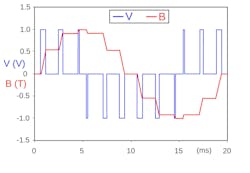Advanced Modulation Techniques: The Key to Improved Power Density?
What you’ll learn:
- What is advanced modulation and why is it getting more attention?
- What are the arguments for employing advanced modulation techniques?
- What are PWM, SVM, SDM, and PVM and how are they used?
Power-density improvements are an increasingly elusive goal as designers exhaust the easiest or most obvious solutions. One direction that’s now being explored more thoroughly is advanced modulation techniques, which may prove crucial for further enhancing power density in electronic systems.
In general, alternate modulation approaches offer an opportunity to optimize switching behavior and component utilization. Techniques include pulse-width modulation (PWM), space vector modulation (SVM), step density modulation (SDM) and proportional-values modulation (PVM). They have been employed to reduce switching losses, minimize component size, and enhance overall efficiency, though this list is far from exhaustive (see figure).
Operating at higher switching frequencies allows for smaller passive components (inductors and capacitors) due to reduced energy storage requirements per cycle. Meanwhile, utilizing devices built on gallium nitride (GaN) and silicon carbide (SiC) enable faster switching speeds, further contributing to miniaturization. Integrating power and control elements on a single chip can also reduce the incidence of parasitic inductance and capacitance, again leading to improved performance and power density.
What Makes Advanced Modulation Methods Worth Employing?
Advanced modulation is one of the less exploited means for wringing more efficiency and power density from a given volume of available space. Implementation isn’t without challenges, but it’s increasingly within reach of available components.
>>Download the PDF of this article, and check out the Series Library for similar articles and videos
Engineers should consider adopting advanced modulation techniques to significantly improve power density in power electronic systems, especially in applications like electric-vehicle charging and data centers. These techniques can offer reduced current ripple, lower total harmonic distortion (THD), and improved efficiency compared to traditional methods like pulse density modulation (PDM), leading to smaller, lighter, and more efficient systems. Some of the choices available include:
Pulse-Width Modulation (PWM)
PWM is a fundamental technique where the width of a pulse is modulated to control the power delivered, widely used in inverters and motor control. PWM controls the average power by adjusting how long the signal stays on during each cycle, all while using digital efficiency and enabling compact, high-performance systems.
PWM uses the duty cycle — the percentage of time the signal is “on” — to control the average power delivered to a load. PWM drives switches (like MOSFETs or IGBTs) fully on or off instead of operating in linear mode.
This means minimal power is dissipated as heat during transitions, reducing the need for large heatsinks or thermal management. PWM enables precise control of voltage and current by adjusting the duty cycle (the ratio of "on" time to total cycle time), which allows for smaller inductors and capacitors, reduces the physical footprint of power converters, and boosts power per unit volume.
Space Vector Modulation (SVM)
SVM is an advanced PWM technique that optimizes switching sequences for better harmonic performance and efficiency, often used in motor drives. SVM improves power density in motor drives and power converters by optimizing how voltage is applied to a three-phase load, such as an AC motor. SVM treats the three-phase output of an inverter as a vector in a 2D space.
Instead of generating sine waves directly, SVM calculates the optimal switching states of the inverter to approximate the desired voltage vector more efficiently than traditional PWM. SVM can reportedly use up to ~15% more of the DC bus voltage than sinusoidal PWM.
Step Density Modulation (SDM)
SDM dynamically adjusts pulse density in discrete steps to minimize current ripple and improve power-transfer efficiency in high-frequency inverters. It’s particularly useful in wireless power transfer (WPT) systems.
SDM improves power density by enabling precise, high-speed, multi-level control of power delivery, typically in digital power conversion or control systems. It’s a digital control strategy where the output waveform is approximated using a series of discrete voltage steps, rather than a continuously modulated signal.
The "density" of these steps — how frequently they occur — determines the average power delivered to the load. Think of it as a refined version of PWM, where instead of just changing pulse widths, you're controlling the density and distribution of voltage steps to synthesize a desired waveform. SDM also allows for extremely fine voltage control using many small discrete steps, especially with high-switching-frequency digital controllers.
Proportional-Values Modulation (PVM)
PVM, an advanced modulation technique for bidirectional DC-DC converters, is designed to minimize reactive power and reduce the size of transformers. PVM is a lesser-known or emerging control method compared to PWM or SVM. It’s generally refers to a technique where switching devices deliver output voltages in proportion to the desired reference values, rather than through fixed duty cycles or discrete step approximations.
While formal definitions may vary, in the context of power electronics and digital control, PVM can be understood as a digital modulation technique. In this case, the output is modulated to match proportional values rather than approximating them via time-slicing (like PWM), and the modulator directly generates voltages or currents proportional to the desired output.
Unlike PWM (which uses time averaging), PVM can generate output signals closer to the desired values in real-time using proportional logic. Because PVM can deliver closer approximations to the target output per switching cycle, it may allow lower switching frequencies for similar accuracy. The proportional nature of PVM can result in smoother waveforms with fewer harmonics compared to traditional PWM.
What are the Bottom-Line Benefits of Advanced Modulation Methods?
Advanced modulation techniques offer several key benefits that contribute to the improved design of modern electronic systems. By enabling more efficient power conversion and reducing the need for large passive components, these methods help decrease the overall size and weight of power supplies and electronic devices. In addition, they minimize switching losses through optimized control strategies, thereby enhancing overall system efficiency.
Advanced modulation also improves power quality, mitigates electromagnetic interference (EMI), and supports better performance across a wide range of applications. Collectively, these advantages contribute to significantly higher power density, allowing engineers to develop smaller, more efficient, and higher-performing electronic systems.
References
>>Download the PDF of this article, and check out the Series Library for similar articles and videos
About the Author




